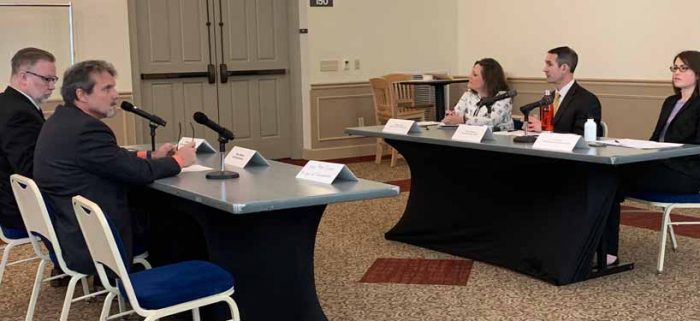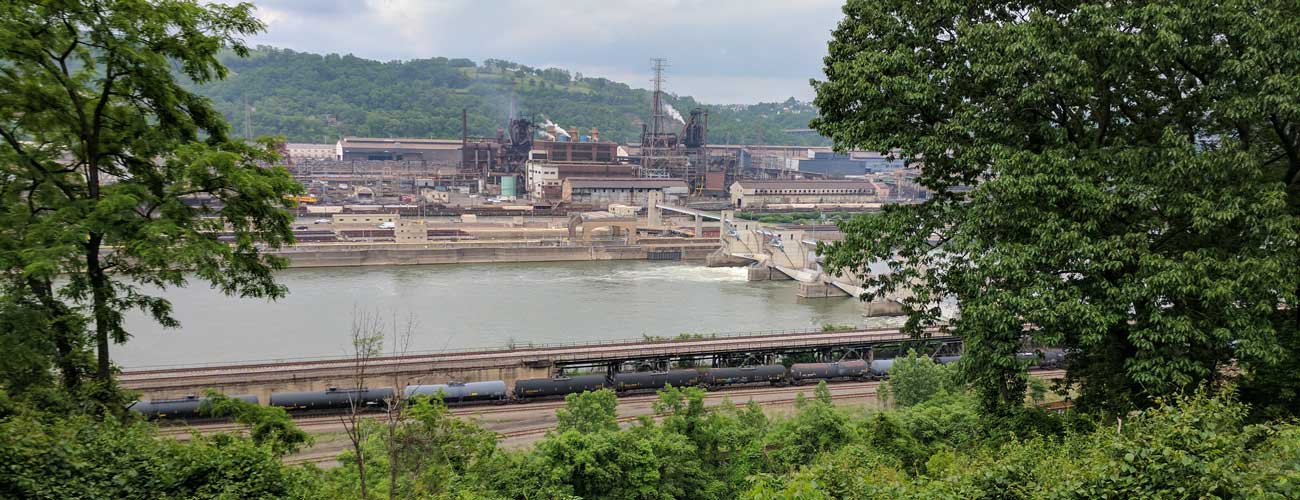Marc Mondor Testifies for State Auditor General on Climate Change
Pennsylvania Auditor General Eugene DePasquale was in Pittsburgh in late March for his second public hearing on the climate change crisis, hosted by Point Park University. According to the department’s website, DePasquale is developing a special report on state government’s response to climate change and steps that can better prepare the state for the future. DePasquale’s hearings have included experts who can help explain how climate change will impact health, transportation and other infrastructure, agriculture, forestry, and tourism – among other issues.
evolveEA Principal, Marc Mondor, gave the following testimony on behalf of AIA Pennsylvania.
 Auditor General Eugene DePasquale, thank you for providing the opportunity discuss this very important topic here today. My name is Marc Mondor and I am a registered architect, I am principal and co-founder of evolve environment::architecture, a green building and sustainability consulting and design firm located in Pittsburgh. I serve as Adjunct Faculty at Chatham University. I am President elect of American Institute of Architects Pennsylvania and am Chair of its Committee on the Environment (COTE). I am also an Appointee to the Pennsylvania Climate Change Advisory Committee, where we are currently providing final review to the forthcoming 2018 Pennsylvania Climate Change Action Plan.
Auditor General Eugene DePasquale, thank you for providing the opportunity discuss this very important topic here today. My name is Marc Mondor and I am a registered architect, I am principal and co-founder of evolve environment::architecture, a green building and sustainability consulting and design firm located in Pittsburgh. I serve as Adjunct Faculty at Chatham University. I am President elect of American Institute of Architects Pennsylvania and am Chair of its Committee on the Environment (COTE). I am also an Appointee to the Pennsylvania Climate Change Advisory Committee, where we are currently providing final review to the forthcoming 2018 Pennsylvania Climate Change Action Plan.
My partner and I founded evolve in 2004 to determine and apply sustainability solutions to the built environment. Back then, making buildings more energy efficient seemed an adequate response, applying US Green Building Council’s LEED rating system to buildings. We moved on to teaching, existing buildings, communications, communities, wellness, resources, organizations, carbon and strategic planning. All of our work is made up of systems, and all of our sustainability work can be seen through the lens of carbon. And it’s not just us – the American Institute of Architects, the venerable professional organization founded in 1857 that now has over 94,000 members as the voice of the construction industry also sees carbon mitigation and adaptability as a top tier priority, as well as a lens through which to see all built environment issues.
The impacts of climate change are ubiquitous thoughout the entire planet. This is not just a belief, as these impacts are measurable, in snapshot, in trend and historically, and while the change is alarming, the accelerating rate of change is even moreso. The scientific community is unequivocal about this body of knowledge. Anyone who denies it is voluntarily choosing to see only a very specific piece of the puzzle as rationalization, not the entire system. Climate change can bee seen as shocks and stressors. The shocks of melting glaciers, species extinctions, hurricanes, forest fires, floods, storm surges are events, they make the news and people notice. Meanwhile, the stressors of droughts, shortened growing seasons, lessened pollination, hottest years on record, waterlogged ground are chronic conditions, occurring in a new reality that did not exist even a mere 20 years ago.
Nationally and globally, the effects of climate change are notable, far-flung and persistent. Focusing on Pennsylvania, according to the US DOE, temperatures have risen 1.8 degrees F in the last century and are expected to increase an addition 5.4 degrees F by 2050; in 30 years, notice the accelerating rate of change. In that same time, precipitation has increased 10 percent and is expected to increase by another 8 percent. And these are averages, made up of episodes. What we can expect are more frequent and extreme weather events, including cloudbursts, large storms, heat waves, periods of drought, heavier snowfalls, flooding in our 50,000 miles of rivers and storm surges on the eastern side of the state. These will in turn lead to increased energy demand, but on a grid and infrastructure that need not only upgrade, but reconception in order to accept, for instance, the coming of electric transportation. This also does not mention the tremendous health impacts on air quality, heat stress, flooding, air and displacement, notably on younger and older Pennsylvanians – in cost, in quality of life and in life expectancy.
I would like to now focus on solutions. I mentioned the Pennsylvania Climate Action Plan, a triennial product of the DEP, forthcoming this Spring. Governor Wolf has announced carbon reduction goals in his Executive Order earlier this year, of 26% by 2025 and 80% by 2050, giving the Plan, and indeed all State efforts, greater focus. The Plan gives an accounting of recent and current emissions, and will focus on the sectors of energy consumption, energy production, agriculture, ecosystems and forestry, outdoor recreation and tourism, waste management, water resources and human health. The previous plans of 2009, 2012 and 2015 have focused on carbon emissions mitigation. The 2018 Plan will also focus, for the first time, on adaptability, and will include financially responsible solutions related to energy efficiency, renewable energy, distributed energy, and efficient transportation, to name a few.
Moving forward, we would like to see a focus on energy efficiency. For buildings, Act 36 of 2017 has made the 2015 building codes standard for the Commonwealth, yet this was a heavy lift on the part of the RAC. We would like to see immediate adoption of the standard ICC building codes as they come out triennially. We support the LEED certifications and advanced energy efficiency on all state-controlled buildings.
We would like to see a health and social equity measure of the impacts of climate change. Triple bottom line solutions account for financial returns and environmental returns, but also returns for the human condition. It’s no secret that poverty demographics overlap with air and water pollution sheds. Improving pollution levels by means of greater accountability can improve the levels of all citizens. These efforts must be seen as investments, providing returns as any other investment would.
We would like to see a greater emphasis on renewable energy, notably solar and wind, which we use, but never use up. Storage is the current great need, and battery costs are being halved every few years. Solar photovoltaics are proving especially adept at the building scale. These give the triple bottom line benefits of greater economic value to the building, offsetting fossil fuel energy production and therefore cleaning the air for better air quality. Pennsylvania needs to increase, upgrade and modernize its renewable portfolio standard (Act 213 of 2004), making more appropriate goals and reducing reliance upon Tier 2 sources. Act 40 of 2018 has been effective at giving Pennsylvania parity with our neighboring states.
Act 129 of 2008 has been highly effective in incentivizing energy efficiency in buildings, providing over $6 billion in economic benefit, as well as correspondingly cleaning the air in reduced production. We would like to see an upgrade of the Act, removing the cap of what utilities can spend, and upgrading the available technologies and strategies. In this session, Senate Bill 232 is attempting to do this.
We would like to see a price on carbon be established and maintained. We can all emit for free, paying money for the fuel, but not for the sink. Carbon emissions have a cost that should be acknowledged. The US EPA established this triple bottom line cost at $36 per ton during the Obama administration, but the EPA does not currently acknowledge this. However, a few states such as Minnesota, recognize it. Using the market forces that drive our economy, those who economize emissions should be rewarded, while the actions of the profligate should be reflected by a financial cost. Rebates have been identified as a way to implement a cost without spooking or stunting the free market.
Transportation currently accounts for a third of Pennsylvania’s emissions. Withholding comment on the condition of our roads, PTC deficits, Act 44, trucker lawsuits, and the like, I’d like to comment on the transportation needs of the coming decades. Our grid will need to meet the needs of electric passenger cars and even trucking fleets. Electric vehicles are 10 times more efficient than internal combustion vehicles and are far more reliable, akin to computers 30 years ago, at the edge of a revolution. Their only Achilles’ Heel is the ability of the electrification grid to address the forthcoming need. Electric vehicles are batteries on wheels, contributing to the forthcoming decentralization of our grid. The transportation associated with access to buildings as we all live our lives is markedly lessened in denser patterns of development, with mass transit and walkability providing carbon reduction and health benefits. A majority of Pennsylvanians live in cities, and funding for mass transit should be seen as a social benefit, as well as a carbon mitigation strategy.
These are our comments in this brief window and, as a reflection of the larger picture, it’s a challenge to make this ubiquitous problem sexy, urgent or even understandable. Yet, this must be part of a sustained effort on your part, and indeed on the part of all in positions of power. On behalf of my firm evolveEA and the American Institute of Architects, we are able to provide further resources to you moving forward, and wish you swift relevance in this effort.


